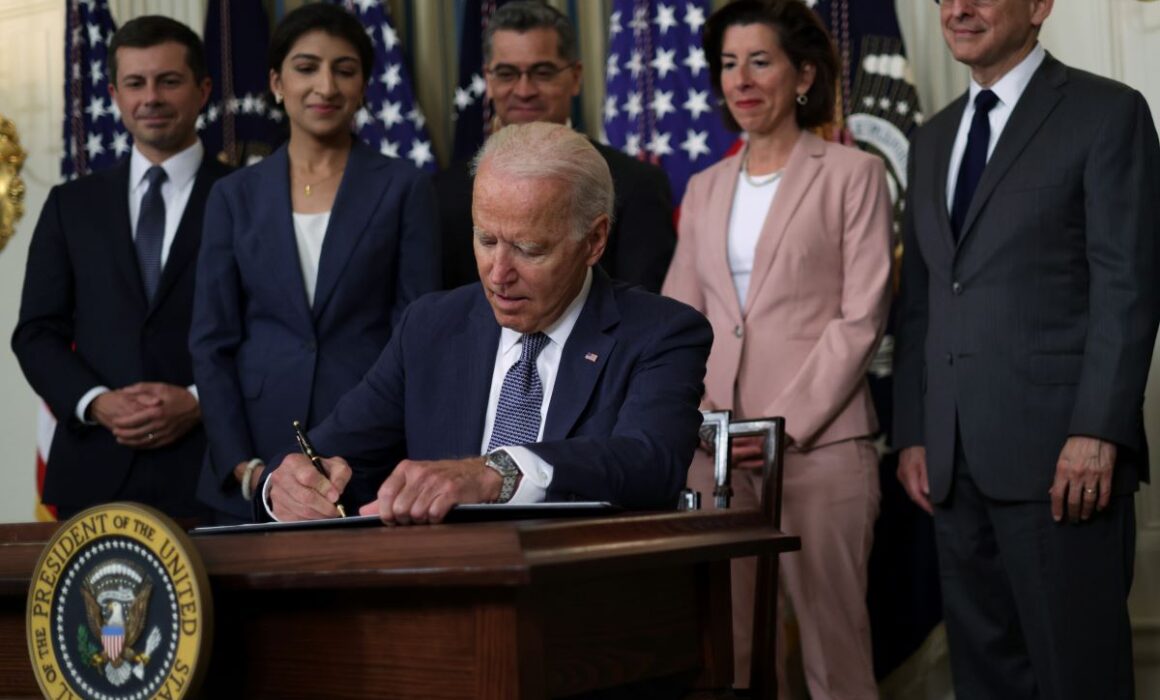Industrial Policy Synergies: Industrial Policy + Competition Policy
April 25, 2023
By Tim Wu

President Joe Biden signs executive order on “promoting competition in the American economy” as (L-R) Secretary of Transportation Pete Buttigieg, FTC Chair Lina Khan, and Secretary of Health and Human Services Xavier Becerra look on during an event at the State Dining Room of the White House on July 9, 2021. (Photo by Alex Wong/Getty Images)
If industrial policy is understood broadly—as more than just throwing money at national champions or favored industries—it becomes obvious that both competition policy and controlling the structure of economic power form an integral part of American industrial policy. They are the levers that serve to either decentralize economic power (or fail to do so), and play a role in preventing any class or region of the country from becoming dominant over the rest, in such a manner as to threaten democracy and lead to unrest.
For the Biden administration, the twin goals of preserving democracy and rebalancing and rebuilding the economy “from the bottom up” made competition policy a natural fit, one of the “pillars” of the administration’s economic policy. It’s why Biden’s Executive Order on Competition of July 9, 2021—which declared an end to a 40-year experiment with weak competition policy—came so early on, and has had such an impact.
It is important to understand why and how competition policy and influence of economic structure form part of industrial policy. Here is a clear example from the tech industries and the 1970s, when the United States faced a significant technology and economic rival in Japan. At the beginning of that decade, the United States high-tech industries were dominated by two monopolies—AT&T and IBM. Power and wealth were concentrated in those two firms, which were also important exporters and partners in national security.
Over the course of US history, it had been the industrial policy to support these firms for a number of reasons, including social goals, like universal telephony, the subsidization of computing research, and also national security goals (AT&T, for example, oversaw some of the nation’s nuclear laboratories). But in the 1970s and 1980s, the government pursued a different policy: trying to break these companies up, in an effort to decentralize economic power in the industries. The government’s efforts had significant effects on the companies and the underlying industries—AT&T was broken into eight pieces, and IBM was forced to allow software to become a separate industry, and create room for companies like Apple in the personal computing industry.
In the next two decades, the US telecom, internet, and computing industries boomed—spurred, in part, by the opening of the markets dominated by AT&T and IBM, and also by another key industrial policy: government funding of the development of the Internet. It is clear, in retrospect, that pursuing these antitrust cases represented an important form of industrial policy. Yes, the United States had helped build up AT&T and IBM—but once they got too big, and too dominant, it helped weaken and ultimately unseat them and make room for new growth and the opening of markets, including markets that had not previously existed.
The Biden administration has embraced this form of industrial policy through competition policy in many industries and markets. The Justice Department and Federal Trade Commission (FTC) have brought or fortified cases against major tech platforms, specifically Facebook and Google, and in that respect have followed the AT&T/IBM/Microsoft approach to stirring up the tech industries. Through agency rulemaking coming out of the Executive Order on Competition, the administration has directly helped open up markets for hearing aids, electric vehicle charging, 5G routers, consumer broadband, and many others. And it has influenced the structure of the economy through the merger policies of appointees like Lina Khan at the FTC and Jonathan Kanter at the Department of Justice, who have changed the baseline of what mergers will be challenged as anticompetitive.
These policies have been undertaken with an eye on the known risks that gross inequality and unaccountable private power pose for a democracy. Louis Brandeis once said that “we can have democracy in this country, or we can have great wealth concentrated in the hands of a few, but we can’t have both.”1 Many countries have seen the rise of strongmen in reaction to economic grievance. President Biden, who announced his candidacy in the wake of the Charlottesville protests, has repeatedly made it clear that he believes that fashioning an economy that works for the whole country is key to democracy’s survival and success. And in this sense, the Biden administration has returned to an important American tradition, dating to our country’s founding. As Noah Webster wrote in 1790: “an equality of property is the very soul of a republic—While this continues, the people will inevitably possess both power and freedom; when this is lost, power departs, liberty expires, and a commonwealth will inevitably assume some other form.”2
About the Author

Tim Wu
Tim Wu is a professor at Columbia Law School, where he focuses on antitrust, with a particular focus on the growing power of the big tech platforms. From 2021 to 2023, he served in the White House National Economic Council, where he worked on tech and competition policy. Wu has also worked in the Obama administration, the Federal Trade Commission, and the New York Attorney General’s Office. He received his JD from Harvard Law School and his bachelor of science from McGill University.
References
1Irving Dilliard, ed. Mr. Justice Brandeis, Great American: Press Opinion and Public Appraisal, (Modern View Press, 1941): 42.
2Noah Webster, An Examination Into the Leading Principles of the Federal Constitution Proposed by the Late Convention Held at Philadelphia: With Answers to the Principal Objections that Have Been Raised Against the System, (Prichard & Hall, in Market Street the second door above Lætitia Court, 1787).